Tinos Island shimmers in the bright October sunlight as the Golden Blue Star Ferry approaches the port of Tinos Town. The marble and granite island’s massive crown, The Rock, dominates the skyline.

A few people told me earlier that half a day was enough to appreciate Tinos. I’m not sure what they meant by “appreciate.” After four days I felt I’d barely skimmed the surface of the cultural and gastronomic delights of this northern Greek Cyclades Island.
My guide, Adriana Flores Bórquez, had planned an ambitious itinerary that could easily have stretched over a week, but we did manage to accomplish all and a bit more. Yet it’s impossible to write about everything this island has to offer in one article. Since gastronomy is such an essential part of Greek life, the island’s wines, beer, spirits, cheeses and sausages are part of what gives Tinos its unique character.
T–Oinos Winery
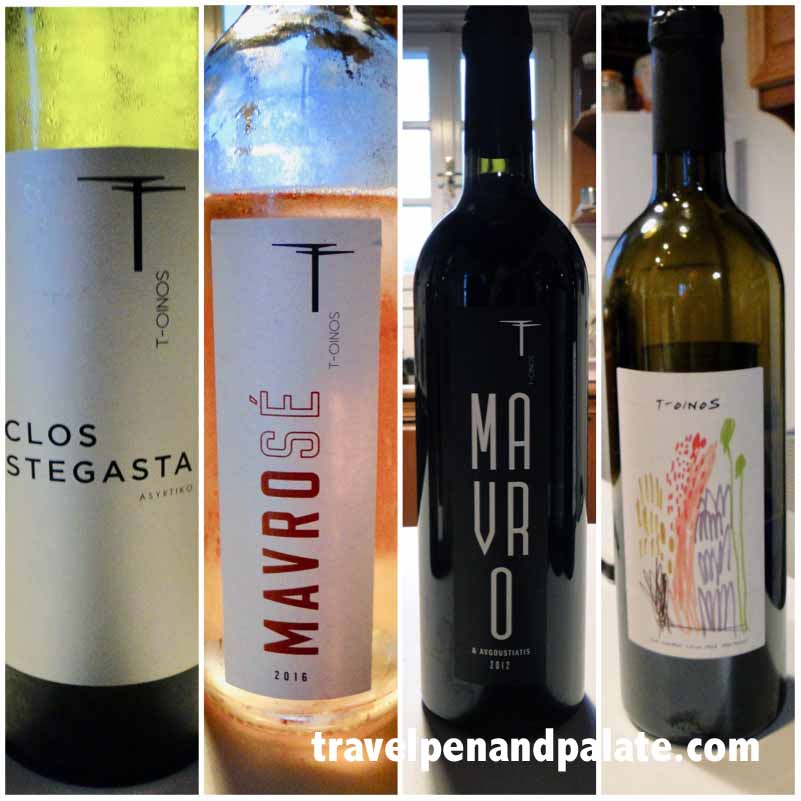
T–Oinos Winery’s production statistics may not impress some, but they haven’t tasted the rich flavors of T-Oinos premium organic wines. And don’t tell that to T-Oinos who take the production of their much sought after vintages seriously.
The over 100,000 vines at T-Oinos ( do check their excellent web site http://www.toinos.com/ ) four locations of terroirs range from granite schist to soft loamy soil at attitudes of 380 to 450 meters (1,250’ to 1,500’). The island provides a well-drained, airy environment on its windy hillsides. Four varieties of grapes are grown, the white Malagousia and Assyrtiko and the red Avgoustiatis and Mavrotragano.
The 2013 Clos Stegasta Assyrtiko had a classic nose of dry summer grasses and vanilla. The tongue picked up fresh lemon and lime zest, which lingered. The throat had the pleasant finish of dry grapefruit zest. Assyrtiko ought to be a Greek national treasure.
Mavrosea blush wine is a blend of malagousia and mavrotragano grapes. It has faint aromas of cranberries, dry roses. Hints of grapefruit were picked up on the tongue. The finish was dry with pleasant aftertaste of refreshing mineral water. A light wine that will not fight with seafood, fish, white meats, cheeses.
T–Oinos 65% Avgoustiatis and 35% Mavrotragano had aromas of tar and white raisins. In the mouth it was the same: tar, white raisin and late summer wild blackberries. The finish was smooth and dry.
T-Oinos 70% Mavrotragano and 30% Avgoustiatis smelled of red currents with subtle floral aromas. It had the smooth, dry taste of ripe fruits with hints of apricots. The finish simply extended the silky smooth flavors. Both red blends would go well with a wide variety of grilled dishes to pastas with red sauces.
The Clos Stegasta Rare (2013) 100% mavrotragano had aromas of red currents with subtle floral hints as well but more intense with a scent of tobacco. In the mouth there were notes of sweet but dry, ripe strawberries and black currents. The flavors coated the tongue lingering in a smooth, dry finish.
The 2011 Mavao – 70% Mavrotragano and 30% Avgoustiatis – is a rare wine from grapes grown on the terrace hillsides. Nose, mouth and finish was a very round wine experience with flavor notes of ripe mixed summer berries and roses with a silky smooth finish extending the taste – a wine to savor on its own.
Chef Aggeliki Vidou and “pumpkin” cheese
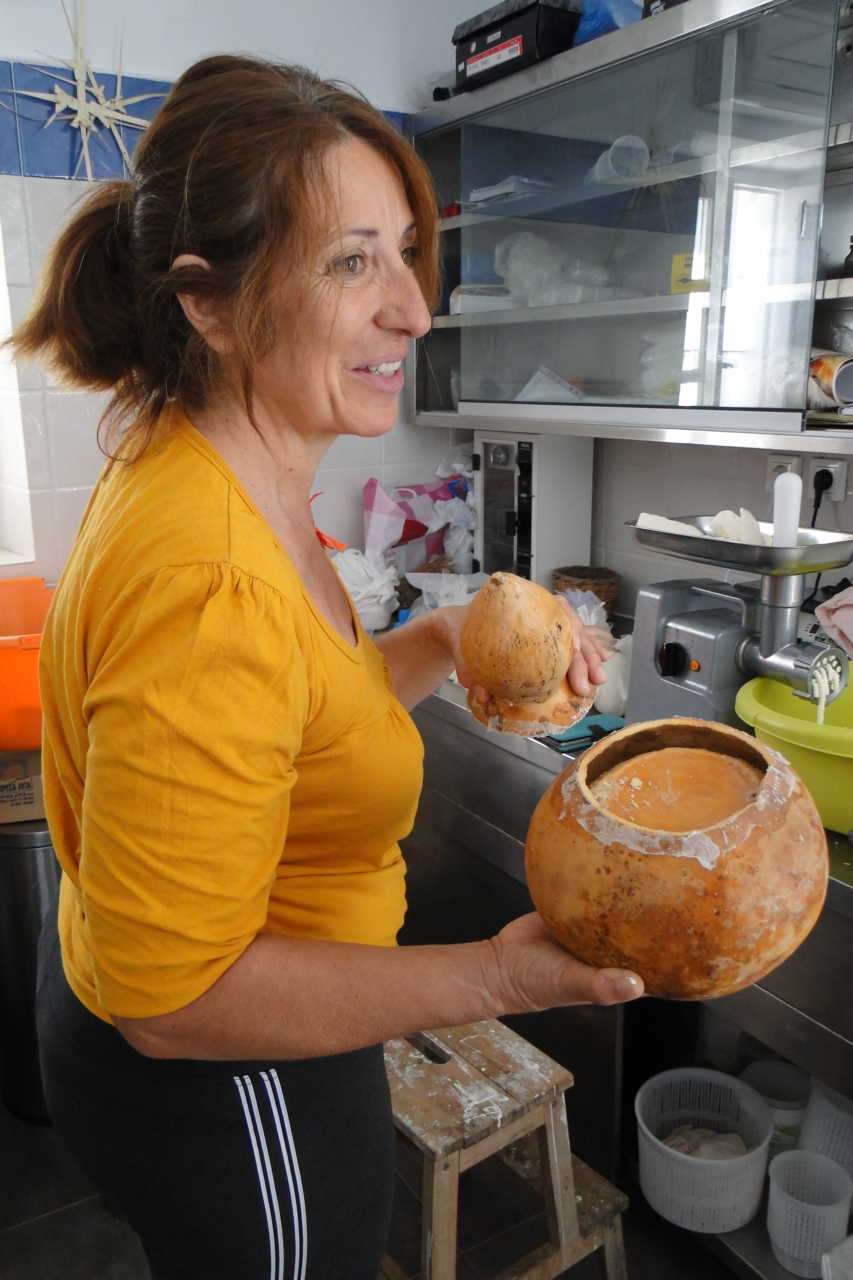
A visit to Tsiknia Mountain to meet chef Aggeliki Vidou to watch her revive a lost art and make sweet cheese pie is a pilgrimage for a turophile –a cheese fanatic. With 20 cows in a bucolic setting, Aggeliki has been commercially making cheese for 18 months. Chef Vidou is the only person in all of Greece making Kariki: pumpkin cheese. Demand outstrips supply, and that’s just from Tinos restaurants!

Chef Aggeliki Vidou Cheese “factory” process in making traditional cheeses of Tinos:
Petia is a base cheese:
- Pasteurize the milk to 66 C
- Add rennet and let the milk sit for 24 hours to separate the curds from the whey.
- Gather into cloth bags and hang over bowls to 2 to 3 hours to drain the whey from the curds.

For Malathouni the curds should be soft before packing into cloth lined baskets.
- Add sea salt before packing into baskets
- Allow the cheese to drain for another 24 hours.
- Remove the cones of cheese and pat with salt water.
- The bags are hung in a cool, airy dray space for 20 days to dry.
For Malathouni in olive oil:
- Dry the cheese for 5 months. Then place in a ceramic or glass jar and cover with extra virgin olive oil.
For Kariki: (pumpkin cheese) The name comes from the small gourd, which is called karika. Traditionally it was used to collect milk. Now the metal containers used are called kariki as well.
- Before the cheese is removed from the cloth that was in the cone they are placed in a pan and weighted down and drained for an additional 24 hours.
- Small gourds are selected. They need to be prepared before use.
- Remove cheese from cloth and pack into the small gourds. Place the lid on top.
- Make a paste of four and water. Use it as a paste to seal the outside of the lid to the gourd.
- Allow to sit for 2 to 3 months in a cool airy place.
For Kopamisti:
- After the salt is added to the Petia add some old Kopamisti to the fresh base cheese. This will add the distinctive tangy flavor to the cheese.
- Age 2 to 3 months.
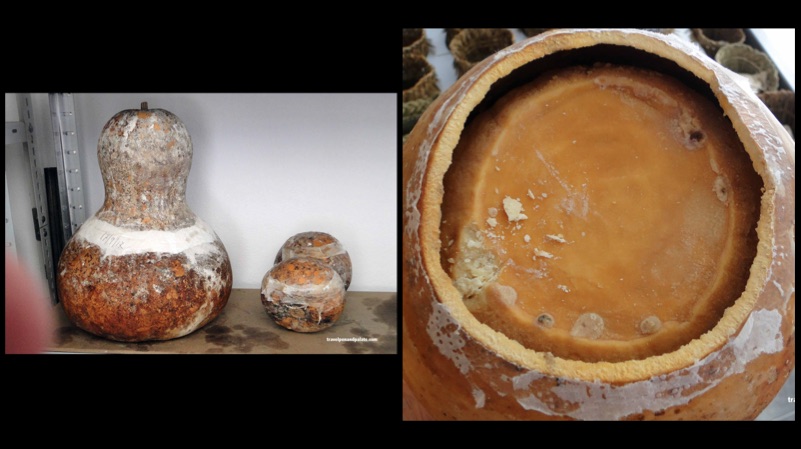
There are endless variations to the classic Greek Orange Pie, and I’ve not found any unenjoyable.
Chef Aggeliki Vidou’s Orange Pie:
Generously butter a large square cake pan or line pie pans with any pastry you use for pies. Chef Aggeliki Vidou’s recipe if for people who just like the filling.
Blend
- 1 kilo (2.2 pounds) fresh Petia cheese.
- 6 to 7 fresh eggs
- grated orange zest from 2 medium sized oranges
- 100 grams/ 3.5 ounces corn flour
- 1 teaspoon cinnamon
- 700 grams/ 25 ounces sugar
- 1 to 2 grams wheat flour
- A fresh weighted batch of Petia cheese is put though a meat grinder.
- Add a generous grating of fresh orange zest to this ground batch of fresh Petia.
- Add sugar, cinnamon, corn flour and eggs. With your hands blend until you have a consistency where you can form a small soft ball in the palm of your hand. It should be slightly sticky but when pushed with a finger it should only make small indentations – add more eggs if needed.
- (variation) leave out the cinnamon and substitute vanilla extract and a small grating of lemon zest.
- Spread the batter into the pastry lined pie pans or buttered cake pans and bake at 180C/ 350F for 1 hour.
I’d say a 2013 Clos Stegasta Assyrtiko would be a good pairing with the orange pie, especially sitting in Aggeliki beautiful garden and viewing the family’s personal chapel.
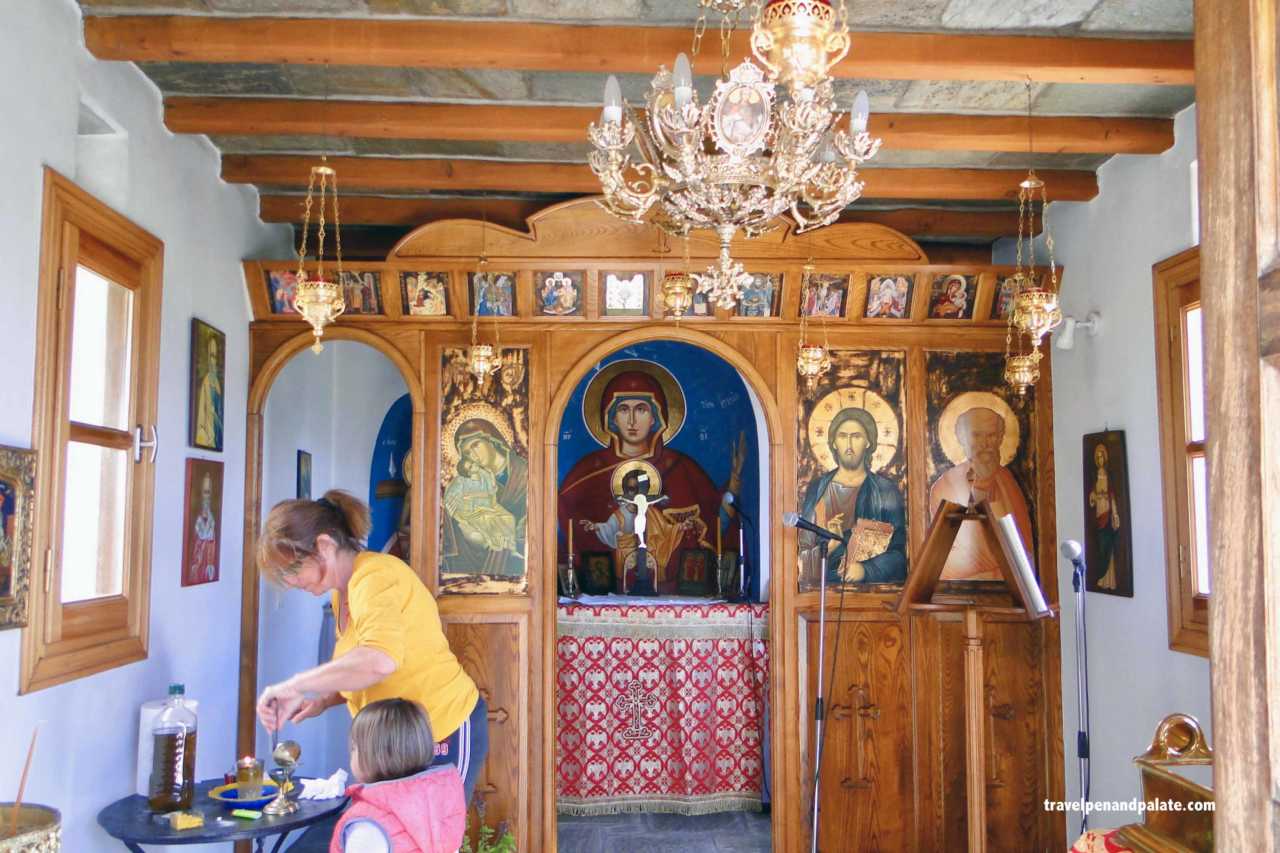

In the village of Kechros San Lorenzo Cheese is a 2.5 year old company. They make cheeses with cows milk and with sheep milk April through August. They invented Kastelano. It’s like a fresh mozzarella but softer. Good grilled and drizzled with honey.
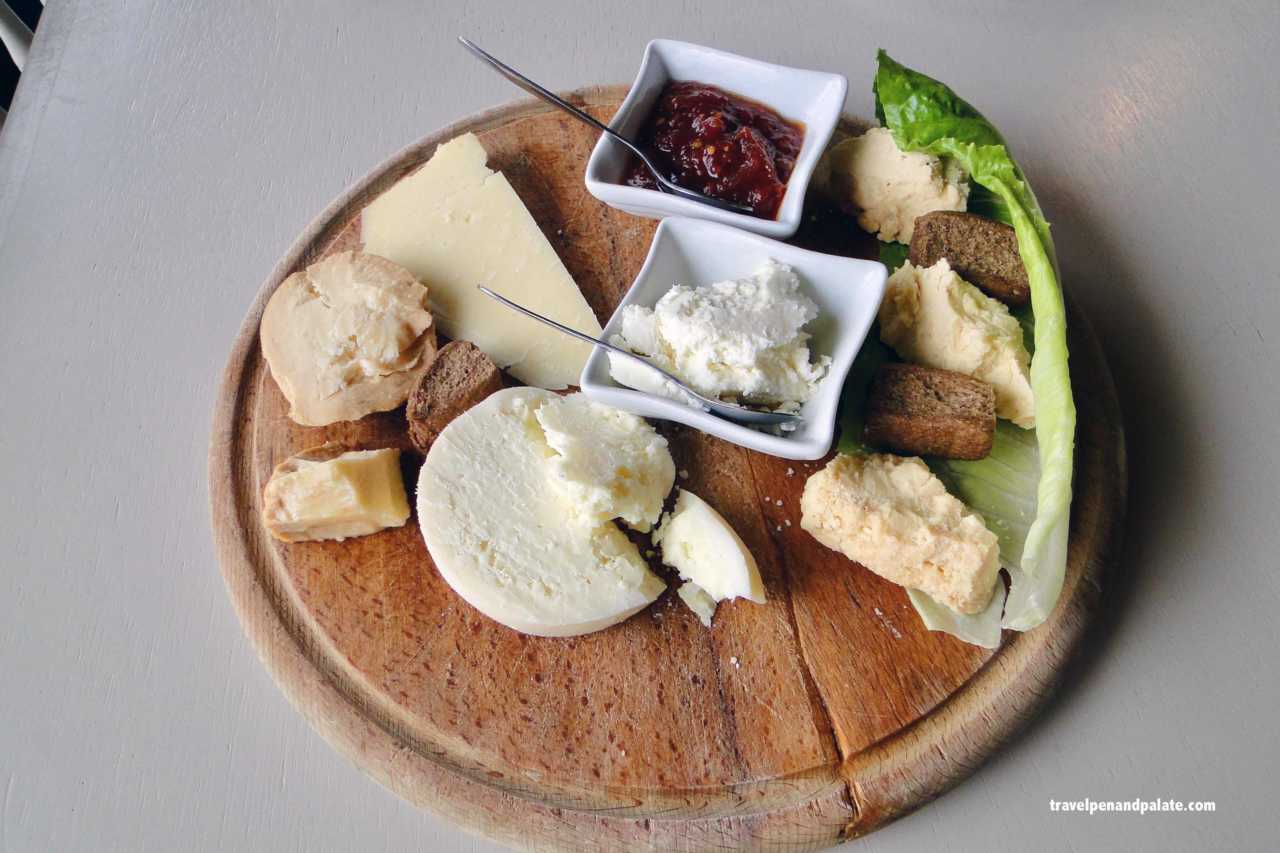
ΝΗΣΟΣ (Island) Brewery
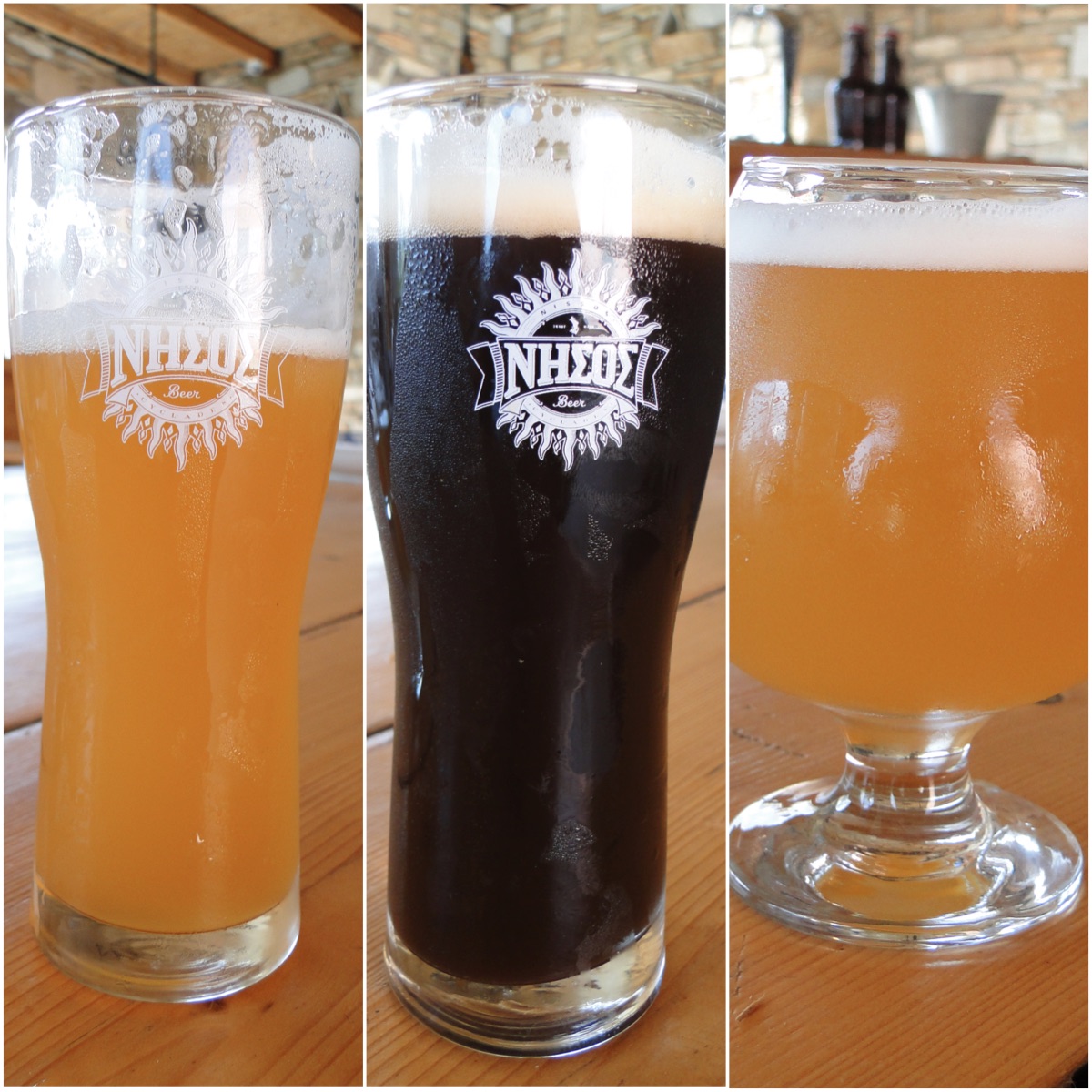
At ΝΗΣΟΣ (Island) Brewery in Chora Lida Dafouli led me through a tasting of some of their award winning brews. Founded in 2012, Alexandros Kouris opened the brewery in the middle of the economic crisis. ΝΗΣΟΣ is the only Greek brewery with European style beers inspired from Germany.

Hops are mostly from Germany and the Czech Republic, although in Thrace brewers use local hops – Thrace grows 70% of the region’s hops.
Micro filtration not pasteurization is used in their process. They do a variety of unfiltered beers for bar tap use, and filtered for commercial bottle sale. Unfiltered beers have a shorter shelf life
The All Day Pilsner reminds me of Belgian blonde beers down to the hint of orange. Creamy head, smooth, balanced and unfiltered. (Goes to market micro filtered). It’s the most popular pilsner in Greece.
Their Pilsner is an award winning unfiltered brew, although it goes to market micro filtered. Medium to light hops. The unfiltered has more flavor. Smooth, the hops leave a tingle on the tongue. Taste of walking through a wheat field. Pair well with mild cheeses, not salty or tangy cheeses that would fight the hops.
No Name is an unfiltered brew under development – 7% alcohol. Toasted hops are evident in the nose and taste. The hops could specifically be from one region and that may be adding to/alter the flavor. Whatever, the hops have a well rounded and refined flavor and a nose at the same time – reason for serving it in a brandy glass – with a hint of smoked gouda and dry apricots. It would pair with stronger cheeses.
7 Before is a not sweet but has a very light molasses flavor, roasting coffee beans and dry prunes. Not a heavy beer but medium weight. Would pair well with mussels steamed in the beer and grilled calamari.
Kritikos – local cured meats
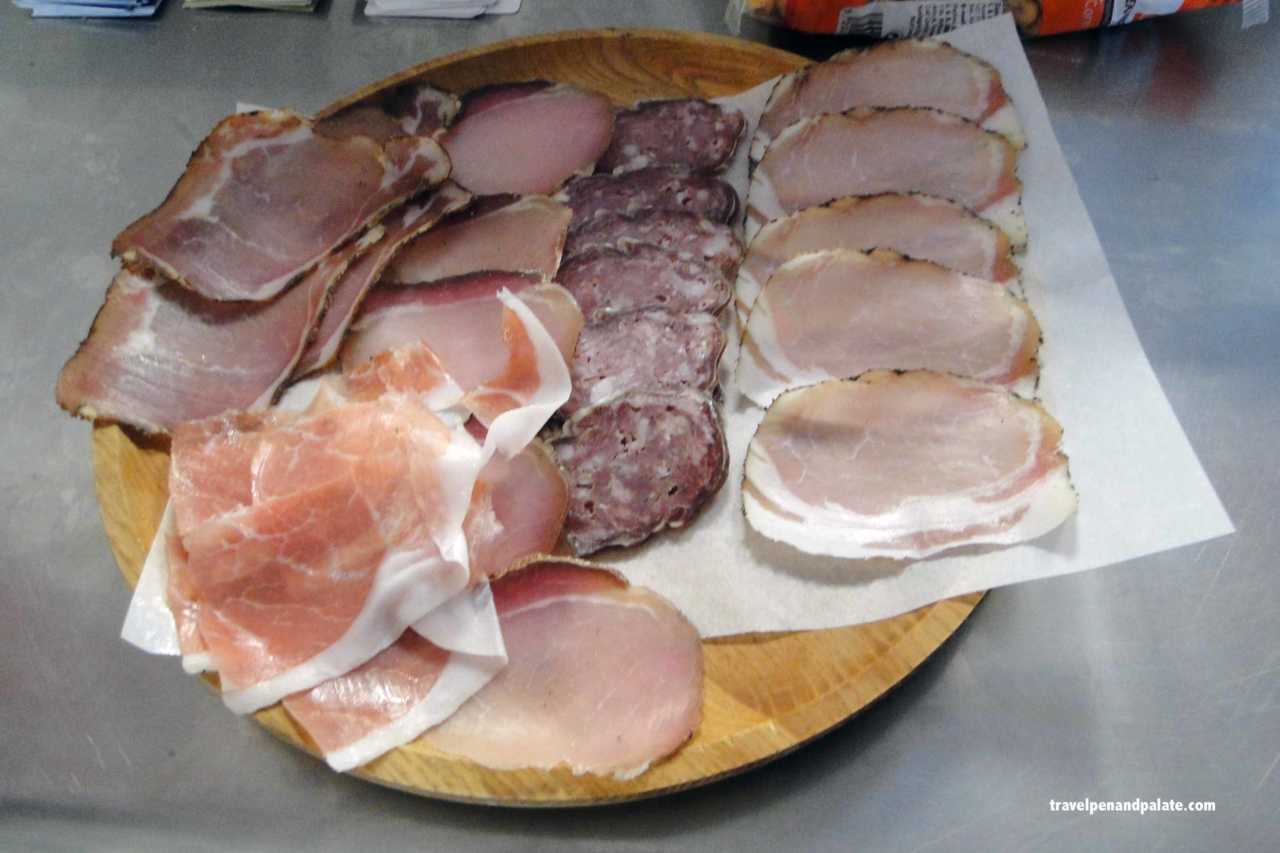
Yannis Kritikos is the third generation of his family in the meat industry with a well established name in Chora. Opening three years ago, he is the only butcher in Tinos for cold cuts. His products are distributed to Germany and the UK as well as throughout Greece. Yannis is known for the quality of the traditional sausages Louza and Tinos.
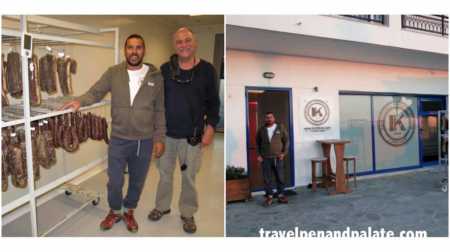
Louza sausage is a specialty of the northern Cyclades. It can also be cured with salt and wine. The meat is kept in salt for the first few days. Then it is immersed for a few days in red wine. Right after it is sprinkled with pepper, allspice, fennel, cloves and savory and finally pressed into wide intestine and hung to dry in the air 20 to 25 days. It is cut into very thin slices and ready to eat. Since it contains no preservatives, keep it refrigerated. Yannis is experimenting with curing Louza with the fat layer included to make it more tender – and it is.
Traditional Tinos sausage is made from pork, salt, red wine and natural spices including wild maratho (anis). It must be cooked before eaten and is often simmered in plain tomato sauce.

Kritikos is listed in the top 40 places to find quality local products according to the Greek Gastronomy Guide. You can purchase their products from the shop-unit in Chora.
St. Modestos, patron saint of butchers, is celebrated on Tinos on the his December Saints’ Day. Collection boxes are left in the churches to get donations to help defray the cost of a small feast for those that honor the saint and for the community.
Visiting a Rakizio

It was thrifty monks on the Holy Mountain Athos that first created raki sometime in the 1400s. The clear distillation of grape skins (strofilia) after crushing them for wine is easy to make and a favorite among Greeks, especially in the north. It’s usually served over ice with a variety of meze.
Raki has the taste similar to a smooth vodka, but with the addition of wild maratho (anis) it takes on that herbs distinctive flavor although no where as sweet as ouzo.
For centuries vineyards large and small made their own raki. In the 20th century small grape producers were granted licenses to market a regulated quantity of their production. High on the windswept hills of Tinos, in a small rakizio (house where riki is made) I enjoyed the experience of watching the process and, like at many rakizios, gathering with family and friends for a simple lunch.
Traditional Raki: makes 10 Liters
- 10 L (2.5 gallons) water & (optional) a large bunch of maratho (wild anis)
- 40 kilos (5.5 gallons) of grape strofilia. At this rakizio they used white grapes: rosaki, potamisio, koumariano and a red grape: mavro potamiso)
- Seal the lid of the still with mud to keep in steam and boil for 90 minutes..
For medicinal uses, the first liter is often removed because it’s at 65% alcohol. If the entire batch is blended the alcohol content is 35%
Tsipouro and raki are virtually the same distillation. If raki is distilled twice it’s usually called tsipouro, especially in Macedonia and Thrace.
The distilling process is continuous for 90 minutes. A temperature gauge tells the distiller when the process must stop for that batch. The fresh, warm raki, with just a hint of maratho, straight from the tap as it streamed into a container tasted smooth with no alcohol burn to the throat.
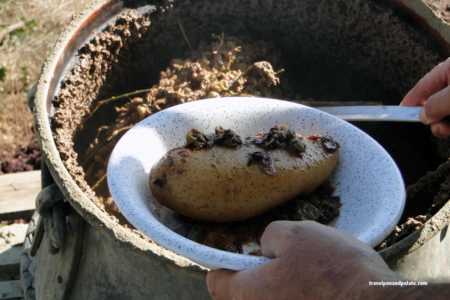
Lunch at the house with the family included pink tomatoes that are a local late summer variety that if the weather is mild will grow until Christmas. Large potatoes are often steamed in the still with the riki and removed after the process. Their tender texture absorbs some of the flavors of the strofilia and maratho. The highlight of the lunch was a large bowl of steamed wild artichokes.
Olive oil drizzled on all the vegetables, rustic bread, fresh raki and experiencing seven centuries of gastronomic tradition was satisfying indeed. There is so much more to write about Tinos for future articles. Yet the gastronomic theme that lures thousands of visitors annually to Tinos is the pride islanders have in local ingredients, tradition and their eagerness to maintain them for the 21st century.
When you go: Tinos Island is easily reached by ferries from the nearby Athens ports of Piraeus and Rafina.
Disclosure: The author was a guest of the businesses mentioned in this article through the cooperation of the Municipality of Tinos Island. Transportation was provided by Dellatolas Rent a Car and accommodations by Hotel Meltemi. Arrangements were facilitated by the MTCgroup.
Travel with Pen and Palate every month to Greece and the world in the Hellenic News of America.








